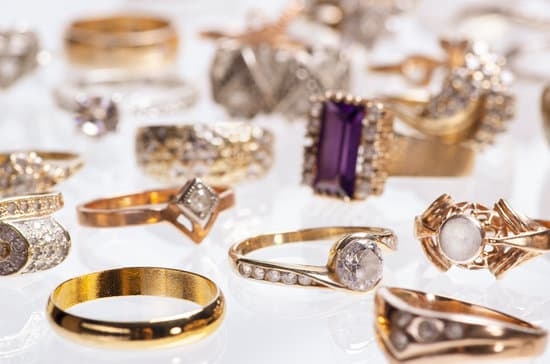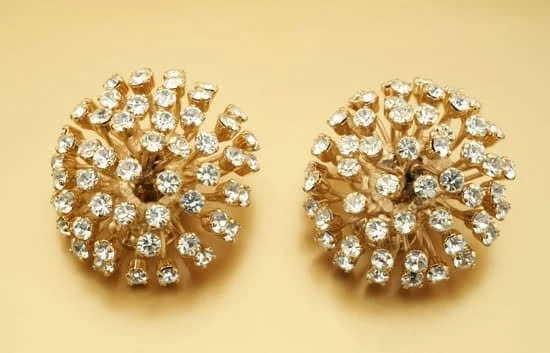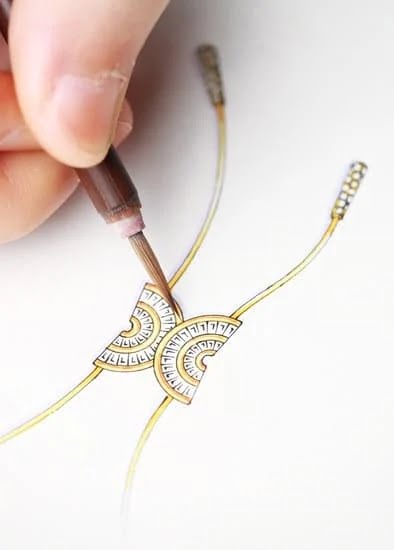Can varnish on jewelry beads cause allergic reaction? For individuals who love wearing jewelry, it is important to understand the potential risks associated with varnish on jewelry beads. This article will delve into the world of varnish on jewelry beads, exploring what it is, how it is used, and the possibility of allergic reactions. Whether you’re a jewelry enthusiast or someone who experiences allergic reactions, this article aims to provide valuable information on this topic.
Varnish is a common protective coating applied to jewelry beads to enhance their durability and appearance. While varnish serves as a protective layer, it can also pose potential health risks for individuals with sensitive skin or allergies. Understanding the role of varnish in jewelry making is essential for anyone looking to avoid allergic reactions caused by this substance.
Allergic reactions to varnish on jewelry beads can manifest in various signs and symptoms, ranging from mild irritation to more severe discomfort. By understanding these symptoms and their potential causes, individuals can better determine if their allergic reactions are related to the varnish used on their jewelry beads. It’s important for jewelry wearers to be aware of these potential risks in order to take proactive measures and seek appropriate treatment when necessary.
What Is Varnish and How Is It Used on Jewelry Beads
Varnish is a type of coating that is commonly used on jewelry beads to give them a glossy, shiny finish. It is often applied to wooden, metal, or plastic beads to enhance their appearance and protect them from wear and tear. Varnish can come in various forms, including spray-on varnish, brush-on varnish, and dip varnish, each offering different application methods and finishes.
Types of Varnish
There are several types of varnishes that are commonly used on jewelry beads. Polyurethane varnish is one of the most common types and is known for its durable and long-lasting finish. Acrylic varnish is another popular choice due to its fast drying time and water-based properties, making it environmentally friendly. There are also epoxy varnishes which provide a thick and protective coating for jewelry beads.
Application Process
The process of applying varnish to jewelry beads typically involves cleaning the surface of the beads to remove any dirt or oils before applying the varnish. Depending on the type of varnish being used, it can be brushed onto the beads or sprayed on using an aerosol can. Once applied, the varnish is left to dry for a specified amount of time before additional coats may be added for increased protection and shine.
Effect on Allergies
While varnishing jewelry beads enhances their appearance and durability, it can also lead to allergic reactions in some individuals. The chemicals present in certain types of varnish
Allergic Reactions to Varnish on Jewelry Beads
When it comes to jewelry beads, varnish is often used to enhance the appearance and durability of the beads. However, it’s important to understand that varnish on jewelry beads can potentially cause allergic reactions in some individuals. It’s crucial for jewelry lovers to be aware of the signs and symptoms of allergic reactions to varnish in order to protect their health and well-being.
Some common signs and symptoms of allergic reactions to varnish on jewelry beads include:
- Skin redness, itching, or rash after wearing varnished jewelry beads
- Swelling or blistering on the skin where the jewelry has been in contact
- Worsening of existing skin conditions such as eczema when wearing varnished jewelry
- In some severe cases, an allergic reaction can lead to hives or even difficulty breathing
If you’ve experienced any of these symptoms after wearing varnished jewelry beads, it’s important to seek medical attention. Allergic reactions can vary from person to person, so it’s essential to have a professional evaluation if you suspect that you may be reacting to the varnish on your jewelry beads.
To determine whether your symptoms are related to an allergic reaction to varnish on your jewelry beads, you can consider conducting a patch test. This involves applying a small amount of the varnished bead material onto a small area of your skin and monitoring for any adverse reactions over a 24-hour period. Keep in mind that this test should only be conducted under the guidance of a healthcare professional due to potential risks.
It’s crucial for individuals who experience allergic reactions to be mindful of the materials used in their jewelry. By understanding the signs and symptoms of allergic reactions and taking proactive steps, such as testing for allergies and seeking alternative non-varnished options, individuals can continue enjoying their love for jewelry without compromising their health.
Common Allergens Found in Varnish on Jewelry Beads
When it comes to jewelry making, varnish is often used as a protective coating for beads to enhance their durability and appearance. However, some individuals may be allergic to certain components found in varnish, leading to skin irritation and other allergic reactions. It’s important for jewelry lovers to be aware of the potential allergens found in varnish on jewelry beads to avoid any adverse effects.
Common Allergens
Certain chemicals and compounds commonly found in varnish can trigger allergic reactions in susceptible individuals. These include formaldehyde, toluene, and various types of resins. Formaldehyde is often used as a preservative in varnishes and can cause skin irritation and dermatitis in some people. Toluene is a solvent found in varnishes that
Risk Factors
It’s important to note that not all jewelry beads are coated with varnish containing these allergens. However, certain types of inexpensive or mass-produced jewelry beads may be more likely to contain these substances. Individuals with pre-existing allergies or sensitive skin may be at higher risk of developing an allergic reaction to varnish on jewelry beads.
Label Reading
To avoid potential allergic reactions from varnished jewelry beads, it’s essential for consumers to carefully read product labels. Look for jewelry beads that are specifically labeled as hypoallergenic or free from common allergens such as formaldehyde and toluene. Opting for high-quality, artisanal jewelry beads made with natural coatings such as beeswax or plant-based sealants can also reduce the risk of exposure to harmful allergens found in varnish.
How to Test for Allergic Reaction to Varnish on Jewelry Beads
Varnish on jewelry beads is a common method used to enhance the appearance and durability of the jewelry. However, for individuals with sensitive skin or allergies, the varnish can cause allergic reactions. It’s important to know how to test for an allergic reaction to varnish on jewelry beads in order to prevent any adverse effects.
One method of testing for allergic reactions to varnish on jewelry beads is by performing a patch test. This involves applying a small amount of the varnished bead onto a small area of the skin, such as the inner wrist or behind the ear. After 24-48 hours, you can check for any signs of irritation, redness, itching, or swelling. If any of these symptoms occur, it may indicate an allergic reaction.
Another way to test for allergic reactions is by using an at-home allergy testing kit specifically designed for testing jewelry components. These kits typically contain materials that mimic common allergens found in varnish on jewelry beads. By following the instructions provided with the kit, you can determine if your skin has a sensitivity to any of these allergens.
It’s also important to consider seeking professional help from an allergist or dermatologist if you suspect an allergic reaction to varnish on jewelry beads. They can perform specialized tests and examinations to diagnose and identify specific allergens causing a reaction. Seeking medical advice and guidance is crucial in understanding and managing allergic reactions caused by varnish on jewelry beads.
Preventing Allergic Reactions
Varnish is a common material used to coat jewelry beads in order to enhance their appearance and durability. However, it is important for jewelry lovers to be aware that varnish on jewelry beads can potentially cause allergic reactions in some individuals. Allergic reactions to varnish on jewelry beads can manifest as redness, itching, swelling, and even blisters on the skin. These symptoms can be uncomfortable and irritating, and in some cases, may even require medical attention.
One of the most important tips for preventing allergic reactions to varnish on jewelry beads is to opt for hypoallergenic jewelry. This type of jewelry is specially designed to minimize the risk of causing allergies in individuals with sensitive skin. Additionally, carefully choosing the type of varnish used on jewelry beads can also help reduce the likelihood of allergic reactions. Water-based varnishes are generally considered safer for individuals prone to allergic reactions compared to solvent-based varnishes.
For those who still want to enjoy wearing jewelry with varnished beads but are concerned about potential allergic reactions, applying a clear nail polish or sealant on the inside of the bead holes can create a barrier between the varnish and the skin. It is also important to regularly clean and inspect your jewelry to ensure that there are no signs of wear or damage to the varnish that could potentially cause an allergic reaction.
With these tips and tricks, individuals can continue enjoying their favorite pieces of jewelry without worrying about allergic reactions caused by varnish on jewelry beads.
| Preventing Allergic Reactions | Tips and Tricks |
|---|---|
| Opt for hypoallergenic jewelry | Choose water-based varnishes over solvent-based ones |
| Apply clear nail polish or sealant inside bead holes | Regularly clean and inspect jewelry for signs of wear or damage |
Treating Allergic Reactions From Varnish on Jewelry Beads
Dealing with an allergic reaction from varnish on jewelry beads can be a frustrating and uncomfortable experience. If you suspect that you are experiencing an allergic reaction from varnish on your jewelry beads, it is important to seek treatment and relief as soon as possible. Common signs of an allergic reaction include itching, redness, rash, swelling, and blisters on the skin. In some severe cases, individuals may even experience difficulty breathing or anaphylaxis.
The first step in treating an allergic reaction to varnish on jewelry beads is to remove the source of the irritation. Take off any jewelry that could be causing the reaction and cleanse the affected area with mild soap and water to remove any remaining varnish residue. Applying a cold compress or anti-itch cream can help reduce discomfort while waiting for medical attention if necessary.
In some cases, over-the-counter antihistamines can provide relief from mild allergic reactions. However, if symptoms persist or worsen, it is crucial to seek medical attention promptly. A healthcare professional can provide proper treatment based on the severity of the allergic reaction and prescribe medications such as corticosteroids or epinephrine if needed.
| Signs of Allergic Reaction | Treatment |
|---|---|
| Itching, redness, rash | Cleanse affected area with mild soap and water; apply cold compress or anti-itch cream |
| Swelling, blisters | Remove source of irritation; seek medical attention if necessary for proper treatment |
| Difficulty breathing or anaphylaxis | Seek immediate medical attention; medication such as epinephrine may be required |
Conclusion
In conclusion, it is evident that varnish on jewelry beads can indeed cause allergic reactions in individuals sensitive to certain allergens found in the varnish. It is crucial for jewelry lovers to be mindful of this potential risk and take necessary precautions when wearing or handling varnished jewelry beads.
Allergic reactions to varnish can range from mild irritation to more severe symptoms, so it is important for individuals to be aware of the signs and symptoms and seek medical attention if needed.
Furthermore, understanding the common allergens found in varnish on jewelry beads can help individuals identify potential triggers for their allergic reactions. By knowing what ingredients to watch out for, individuals can make informed decisions when purchasing or wearing varnished jewelry beads. Additionally, learning how to test for allergic reactions and taking preventive measures can help minimize the risk of experiencing uncomfortable or harmful symptoms.
For those who have already experienced allergic reactions to varnish on jewelry beads, it is essential to know how to treat these reactions effectively. Seeking medical advice and using appropriate medications or remedies can help alleviate symptoms and prevent further discomfort. Ultimately, being mindful of the presence of varnish on jewelry beads is crucial for allergic individuals, as it allows them to enjoy their favorite accessories while minimizing the risk of experiencing adverse reactions.
Frequently Asked Questions
What Is the Most Common Cause of Jewelry Allergy?
The most common cause of jewelry allergy is nickel. Nickel can be found in many types of metal jewelry, particularly in inexpensive or costume jewelry. When it comes into contact with the skin, it can cause an allergic reaction.
What Materials Irritate the Skin for Jewelry?
Materials that commonly irritate the skin for jewelry include nickel, as mentioned earlier, as well as cobalt and certain types of metal alloys. These materials can cause redness, itching, and swelling when they come into contact with the skin.
How Do You Get Rid of an Allergic Reaction to Jewelry?
To get rid of an allergic reaction to jewelry, the first step is to remove the offending piece of jewelry. Then, clean the affected area with mild soap and water to remove any remaining residue from the jewelry.
Applying a cool compress or anti-itch cream can help reduce any discomfort or inflammation. If the symptoms persist or worsen, it’s important to seek medical attention for further treatment options.

Welcome to my jewelry blog! My name is Sarah and I am the owner of this blog.
I love making jewelry and sharing my creations with others.
So whether you’re someone who loves wearing jewelry yourself or simply enjoys learning about it, be sure to check out my blog for insightful posts on everything related to this exciting topic!





